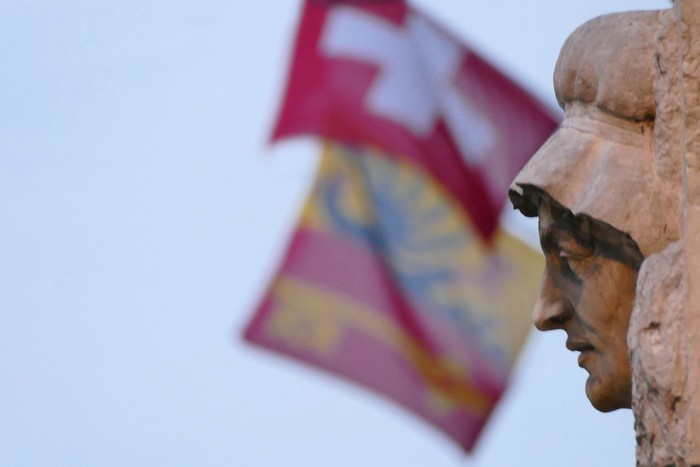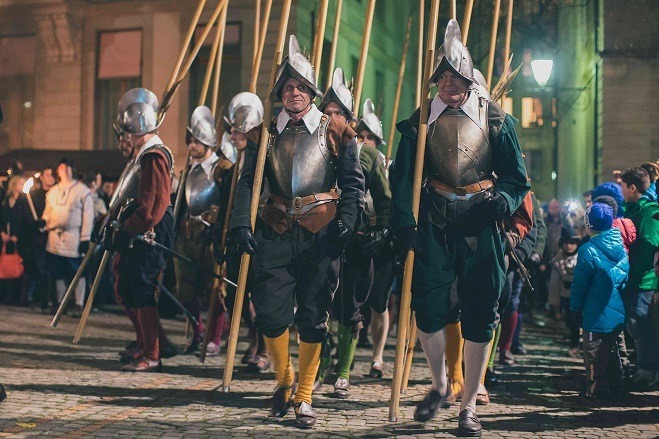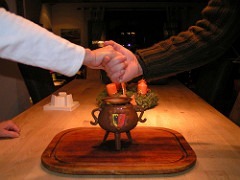
A proud Geneva-born citizen is not surprised to see a little Spiderman, Batman or other little monster on the street in December. But for those who were not raised in this multicultural city, it can be strange. They might think “Halloween was almost 2 months ago and these kids must be late or out of their minds”. But in fact, they are perpetrating a myth. Instead of the Halloween candies given at the end of October, we offer them coins. But to earn coins, they need to sing the traditional song from “the Escalade”.
They might start singing “Ce que laîno” in old French, or the modern version “A la belle Escalade”, less historical, but more likely to be taught in school. Earlier that day, those same kids went to school with vegetables to prepare the traditional soup served in the evening.
After listening to a pretty strange song and then giving a few coins to a monster, a foreigner’s interest is piqued about this so-called “Escalade”.

So what is the “Escalade”? Or shall we say: what are we celebrating?
To transmit just half of the passion and pride Genevans have for this event without a few boring historical facts will be impossible, so here is a very brief history lesson.
Back in 1602...
The city of Geneva has always been coveted by the Savoyards. It became even more important for them to take on the city when the French kingdom got bigger by taking over the province of Bresse and all of the land towards the Rhône River. It was also the first time that the city of Geneva had the French kingdom as a neighbor. Surrounded by enemies, its only allies, Bern and Soleure, were not geographically close.
Charles-Emmanuel de Savoie, the “Duke of Savoie”, always wanted to make Geneva part of the Savoie region, and after all the efforts of the Calvinist Protestants to “free” the city from the Catholic church, he wanted to bring Catholicism back. A peace treaty was supposed to be in place, and even the Pope was not keen on trying to take back the city. At least that is what Geneva’s citizens thought before a fateful night in December of 1602.
Charles Emmanuel chose the longest and darkest night of winter to attack the city in order to surprise the sleeping citizens. His army of over 2000 men surrounded the city the night of December 11. A small group entered by its weakest side, near the street today known as Corraterie, by marching along the Arve River first and then the Rhône. That way their noise was covered by the sound of the flowing water and mills. Their objective was to open the “de Neuve” gate in order to let in the rest of the army that was waiting near Plainpalais.
By then, victory was already pronounced by the Savoyards. Charles Emmanuel got the message from his position in Etrembières and began announcing the occupation of Geneva to all of his European allies. However, alerted by the noises, two sentinels left their posts and found themselves face-to-face with Savoyard enemies within the city.
The first one was killed directly, but the second one had just enough time to fire off a shot. At 2:30 am, the alarm bells went off in the city. The Clemence, the largest bell of the cathedral, brought all the citizens clamoring from their warm beds to get their guns. Most of them started the fight in pyjamas, ladies and gentlemen scrambling and giving their lives to defend the city.
The war went on from Belair to place de Neuve. At this point, the Savoyards could still have won the fight if they had succeeded in opening the gate de Neuve. However, Isaac Mercier, one of the main heroes of this war, understood the strategy of Charles Emmanuel’s troops and was able to cut the chain which was holding the gate. This closed off the city to its enemies. The Savoyards found themselves trapped inside the walls of the city.
When they heard the noise coming from the city, the troops in Plainpalais start running towards it thinking the gates had opened. Instead of opened gates, they were welcomed by cannon balls fired by the Genevan guards. The city came out victorious, with 72 victims on the Savoyard side against 18 Geneva citizens. Of the 18 victims, only two of them were soldiers. 67 Savoyard heads remained on wooden sticks on Geneva’s walls to show the enemies what could happen if they tried again. As for Charles-Emmanuel, with such a big army, he should never have lost that battle.
The Escalade today
The celebration of this win, however, was soon prohibited. When Geneva became part of France years later in 1795, they were certainly not allowed to humiliate their own compatriots. Then everything changed in 1815, when Geneva once again became part of Switzerland as it entered the Confederation Helvetica. From that point on, every year, we celebrate the Escalade in Geneva on the closest weekend to the historical date.
This weekend, go downtown in the old town to discover the traditions from 1602 and the Genevan lifestyle back then. You will see artisans, guards, religious figures and citizens, all dressed up in historical costumes. Soup and hot wine stands are set up in the streets. This is also the only time during the year that you can walk through the secret Monnetier passage that winds between two residential buildings, so skinny that you have to walk through it sideways.
The highlight of the weekend is the historical parade on Sunday evening, where costumed soldiers and citizens walk through the historical old town with bands playing drums and flutes. The proclamation is read in different strategic points within the city by a costumed man on a horse. To really experience the great and warm feeling of the Escalade, grab a cup of hot wine before hitting the parade. Being born in Geneva will not matter at this point. Everyone is a proud citizen of Calvin’s city celebrating victory.
This is Switzerland! Where's the chocolate?
Last but not least, don’t forget to buy a chocolate marmite which appears in stores at the beginning of December.  The chocolate marmite symbolizes the pot filled with hot soup that one important character from this event, La Mère Royaume, threw from her kitchen window on the head of a Savoyard. We fill it with marzipan vegetables to symbolize the soup and the tradition prior to eating it is to have the youngest and oldest people in the room break it, declaring “ainsi périrent les ennemis de la République”, or “and so perish the Enemies of the Republic”!
The chocolate marmite symbolizes the pot filled with hot soup that one important character from this event, La Mère Royaume, threw from her kitchen window on the head of a Savoyard. We fill it with marzipan vegetables to symbolize the soup and the tradition prior to eating it is to have the youngest and oldest people in the room break it, declaring “ainsi périrent les ennemis de la République”, or “and so perish the Enemies of the Republic”!
Source: https://en.wikipedia.org/wiki/L%27Escalade
Photo credits : René Torres, Kwaito via Flickr under Creative Commons licence